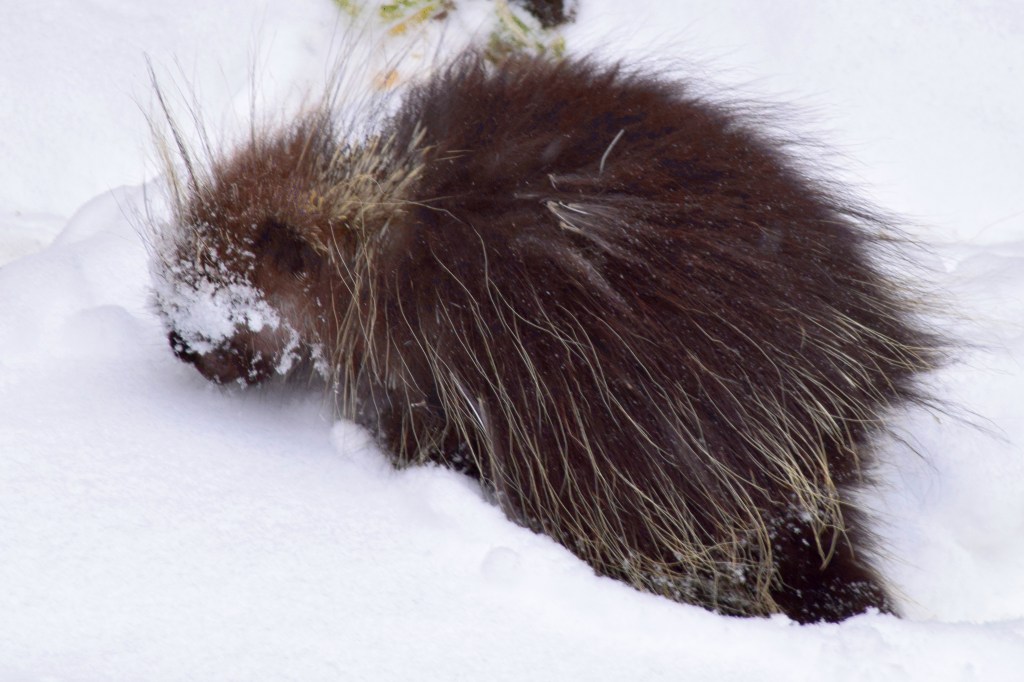One summer night there was a bigger commotion than usual near the bird feeder, which hangs in a birch tree among the firs, hemlocks, cedars and spruces that rise like a wall 15 feet from the kitchen. I turned on the light and looked out through the full-length glass of the door. Things were churning out there.
I got a flashlight and waved the beam around in the trees. A raccoon had shinnied up the birch and was trying to unscrew the top of the bird feeder with his deft little hands. Another adult was on the ground with a bunch of little ones patrolling around just off the deck. They all looked up.
They had that healthy-looking silvery gray fur, striped tail. Black nose. Dark-framed eyes, shining. The one in the tree stared straight into my eyes. While he was thinking one thing in his little brain, I was trying to divine his thoughts in mine. I wondered if he was wondering: What goes on in there, anyway? I have no idea what raccoons think, of course, but my own theory of mind tells me they do.
They know where comestibles appear, and so their routines brush up against the ones Bonnie and I keep down here in the hollow where we live, mostly like hermits, apart from our trudge up the driveway to work. We need to eat, like the raccoon in the bird feeder. And the skunks who amble around the backyard more or less fearlessly. From time to time they clamber onto the deck and get up on their hind legs to peer in the kitchen door. Does a skunk do a different kind of wondering, behind those opaque black eyes, than a raccoon does?
Through the glass one morning we watched a weasel dart darkly past, maybe 30 feet into the woods. White and slinky, a black-tipped tail. Dangerous teeth. A group of deer forages the roughly square-mile territory our 9 acres occupy here in boreal Waldo County. Their hoof prints mark the snow where they routinely cross the driveway. Sometimes rabbit, turkey or cat tracks crisscross them and disappear into the woods like stray thoughts. Back up the hill behind the house I’ve seen what I’m pretty sure were bear tracks.
One night a week or so ago, while I was at work and for all intents and purposes had ceased to exist, Bonnie heard something scratching on the side of the house. At first she swore because she figured it was the squirrels again, the little brutes who are a downright nuisance. This was outside the kitchen wall, though, not a place the squirrels usually torment. And it was loud. Really loud. Much bigger than squirrel-loud. It scrabbled across the wall and over the door. She was suddenly a little nervous.
When it sounded like it had cleared the doorway, Bonnie cautiously looked through the glass, but it had climbed too high up to see. I’m guessing it was investigating the Havahart trap I tacked up on the logs and baited with nuts and sunflower seeds to try to catch the squirrels (with no success whatsoever). When she carefully opened the door to look, there, resting on the logs up over the door, was a porcupine, quills and all.
Yikes! Porcupines climb houses? We had seen one recently make its way with purposeful deliberation from the garage — where I’ve often seen their tranquil Pooh-bear faces and giant brush of spines in my headlights on summer nights — across the driveway and under the deck. Later we noted its tracks emerging from under the kitchen side of the deck and trundling into the woods.
It turns out porcupines spend quite a bit of time climbing trees. In summer they eat vegetation such as clover, shrubs, wildflowers, seeds, and in winter when that kind of stuff is scarce, they eat the bark of birch, hemlock and spruce, among others, and according to one source they have a taste for plywood, possibly because of the glue. Where they’re abundant they can do considerable damage to commercial timber, though the fact sheets I consulted indicate porcupines don’t actually kill trees.
Bonnie had nothing to fear from the quills because she didn’t touch them. They don’t shoot, as is sometimes believed, but the porcupine fans them out when it feels threatened, and they detach on contact and lock into the predator’s flesh. When I was a kid we had a very weak-minded German shepherd who had to be carted off to several overnight stays at the vet after he tried to bite porcupines.
This fellow lowering himself down the door frame had broken his routine to explore the foraging possibilities higher up. Apparently he didn’t find anything worth going back for, because we haven’t heard him again. (I say him — we have no idea if it was a male or a female.)
The squirrels have repeatedly cleaned out the trap without springing it. The raccoons have emptied the bird feeder. The skunks root around in the compost corral. They’re just making their livings. What they’re thinking about, I don’t know, unless they love the woods for the same reason I do. It’s all home to them.
Dana Wilde lives in Troy. You can contact him at naturalist1@dwildepress.net. Backyard Naturalist appears the second and fourth Thursdays each month.
Send questions/comments to the editors.




Success. Please wait for the page to reload. If the page does not reload within 5 seconds, please refresh the page.
Enter your email and password to access comments.
Hi, to comment on stories you must . This profile is in addition to your subscription and website login.
Already have a commenting profile? .
Invalid username/password.
Please check your email to confirm and complete your registration.
Only subscribers are eligible to post comments. Please subscribe or login first for digital access. Here’s why.
Use the form below to reset your password. When you've submitted your account email, we will send an email with a reset code.